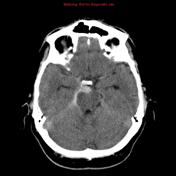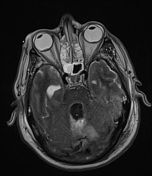Search results for “subarachnoid hemorrhage”
28 results found
Case
Perimesencephalic subarachnoid hemorrhage

Published
16 Aug 2010
83% complete
CT
Case
Snake bite induced subarachnoid hemorrhage

Published
01 Aug 2016
86% complete
CT
Case
Ruptured dermoid and subarachnoid hemorrhage

Published
29 Nov 2013
75% complete
CT
DSA (angiography)
Case
Aneurysmal subarachnoid hemorrhage and Moya Moya disease

Published
15 Feb 2015
80% complete
CT
DSA (angiography)
Article
Terson syndrome
Terson syndrome refers to intraocular hemorrhage in patients with intracranial hemorrhage.
Terminology
The traditional definition of Terson syndrome was vitreous hemorrhage associated with subarachnoid hemorrhage. However, there is also a broader definition which captures intraocular hemorrhag...
Article
Vertebral artery dissection
Vertebral artery dissection, like arterial dissection elsewhere, is a result of blood entering the media through a tear in the intima of the vertebral artery. It is potentially lethal and can be difficult to diagnose clinically and radiologically.
Epidemiology
Vertebral artery dissections have...
Article
Caroticocavernous fistula
Caroticocavernous fistulas represent abnormal communication between the carotid circulation and the cavernous sinus. They can be classified as direct or indirect which are separate conditions with different etiologies.
Epidemiology
Direct caroticocavernous fistulas are often secondary to tra...
Article
Subarachnoid cisterns
The subarachnoid cisterns, or basal cisterns, are compartments within the subarachnoid space where the pia mater and arachnoid membrane are not in close approximation and cerebrospinal fluid (CSF) forms pools or cisterns (Latin: "box"). As they are interconnected, their patency is essential for ...
Article
Fibromuscular dysplasia
Fibromuscular dysplasia (FMD) is a heterogeneous group of vascular lesions characterized by idiopathic, non-inflammatory, and non-atherosclerotic angiopathy of small and medium-sized arteries.
Epidemiology
The prevalence is unknown 7. It is most common in young women with a female to male rati...
Article
Dolichoectasia
The term dolichoectasia means dilated and elongated. It is used to characterize arteries that have shown a significant deterioration of their tunica intima (and occasionally the tunica media), weakening the vessel walls and causing the artery to elongate and distend.
Epidemiology
Dolichoectasi...
Article
COL4A1-related disorders
COL4A1-related disorders are a group of autosomal dominant disorders caused by a mutation in the COL4A1 gene.
Epidemiology
The exact prevalence is unknown, but the group of disorders is considered to be under-recognized, especially asymptomatic variants 1.
Clinical presentation
The clinical ...
Article
Vitreous hemorrhage
Vitreous hemorrhage refers to bleeding into the vitreous humor.
Epidemiology
Vitreous hemorrhage has an incidence of approximately 7 in 100,000 1,2.
Clinical presentation
The most common clinical presentation is with sudden, painless visual loss to varying degrees of severity 2. Associated...
Article
Temporal bone fracture
Temporal bone fracture is usually a sequela of significant blunt head injury. In addition to potential damage to hearing and the facial nerve, associated intracranial injuries, such as extra-axial hemorrhage, diffuse axonal injury and cerebral contusions are common. Early identification of tempo...
Article
Depressed skull fracture
Depressed skull fractures result in the bone of the skull vault being folded (depressed) inward into the cerebral parenchyma. It is usually the result of a high energy impact to the skull.
Pathology
These mostly (~75%) occur in the frontoparietal region 3.
Associations
There are a number of ...
Article
Carotid artery stenosis
Carotid artery stenosis, also known as extracranial carotid artery stenosis, is usually caused by an atherosclerotic process and is one of the major causes of stroke and transient ischemic attack (TIA).
This article refers to stenosis involving the carotid bulb and the proximal segment of inte...
Article
Coccidioidomycosis
Coccidioidomycosis refers to an infection caused by the dimorphic fungus Coccidioides spp., usually localized to the lungs. This disease is not to be confused with the similarly named paracoccidioidomycosis.
Epidemiology
The most common species of Coccidioides are Coccidioides immitis and Cocc...
Article
Internal carotid artery dissection
Internal carotid artery (ICA) dissection, like arterial dissection elsewhere, is a result of blood entering the media through a tear in the intima 1 and is a common cause of stroke in younger patients.
Epidemiology
Dissection may occur at any age but is a common cause of stroke in young patien...
Article
Wyburn-Mason syndrome
Wyburn-Mason syndrome (also known as Bonnet-Dechaume-Blanc syndrome) is a rare, nonhereditary neurocutaneous disorder that typically presents with unilateral vascular malformations that primarily involve the brain, orbits and facial structures. It is currently classified as a cerebrofacial arter...
Case
Brain death

Published
16 Apr 2023
95% complete
CT
Nuclear medicine
Case
Terson syndrome

Published
21 Nov 2017
86% complete
MRI









 Unable to process the form. Check for errors and try again.
Unable to process the form. Check for errors and try again.